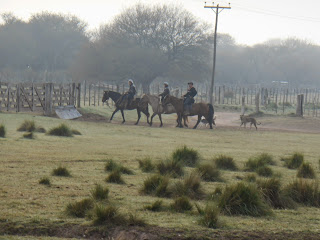Fire up the pit, here I come!!!!!
Search The Blog
Saturday, May 9, 2015
Rancho Salvaje Safaris (Ingeniero Luiggi, Argentina)
After months of anticipation, the time had finally come for the seven-day Argentinian bird hunt that I had planned with my dad and some friends of ours. Woohoo!!! During the first two days I'd already fired off nearly 800 shells through my 12-gauge Benelli M2, dispatching all manner of doves, ducks, and parakeets. For the third day, we were scheduled for a full-day pigeon hunt at the nearby La Isabel ranch. My shoulder was sure to be black and blue by the end of it.
La Isabel is a massive ranch, somewhere in the neighborhood of twenty-five thousand acres. As we drove around to find our hunting grounds, I couldn't help but marvel at the seemingly-endless fields of corn, sorghum, wheat, and alfalfa, each of which was probably at least a thousand acres. Besides the obvious agricultural uses, I'm sure that all of these crops are also sorely needed to feed the five-thousand or so head of cattle roaming the ranch.
The hordes of pigeons and doves don't migrate and absolutely decimate the farmland here, leaving entire fields nearly picked clean of seed. They also repopulate astonishingly fast, at least ten times faster than the American mourning dove (while some estimates put the rate closer to twenty or thirty times faster, especially near Cordoba). Wildlife experts have estimated that around twenty million doves must be killed every year just to keep the population level, and pigeons aren't far behind, so don't feel too bad for them.
The morning hunt was a little slower than expected. We had already gotten accustomed to seeing wave after wave of doves during the two days prior. Apparently the pigeons here hadn't drunk their morning cup of coffee yet and were a bit sluggish (at least according to my guide). Despite the limited flyovers, I was still able to snag a fairly decent hall of birds.
Early hunts always make me famished by the time lunch finally rolls around. I'm glad I had a decent appetite though, because we were in for a special treat today. The guides were preparing an Argentinian asado (barbecue) picnic for us out on the ranch. I was expecting more of a rugged meal, something along the lines of paper plates and folding lawn chairs. To my surprise and my delight, I arrived to the picnic spot to find a beautiful table-and-chair setup with cured meat and cheese hors d'oeuvres already laid out, along with a wine pairing. We definitely weren't roughing it.
The main course was being cooked a la parrilla. Essentially, the meat is cooked on a grill via direct heat over wood lump coals, much like the West Texas style (aka "cowboy style") of barbecue. I was instantly drawn to the large hunk of what I assumed was brisket, but the chorizo sausage and flanken-cut short ribs looked incredible, too. There was also some flank steak tossed on the grill for good measure, just in case we were extra hungry.
Since the guides seemed more partial to the short ribs and flank steak, we decided to forgo it and focus our efforts on the brisket and chorizo instead.
When you hear the word chorizo, it probably conjures up images of a red Mexican sausage with tons of spices. However, in Argentina, chorizo is simply the term used for any coarse-ground sausage. These links were all pork and all delicious. The casings were fantastically crispy and had a great char from the grill. Argentinians don't seem to use a lot of spices in their cooking, so the natural pork flavors stood out beautifully. The guides ate their chorizo in little choripan sandwiches (pan means bread, so chorizo + pan = choripan), but I thought it was perfect all by itself.
It certainly didn't look like the Texas brisket I'm used to, but it looked amazing nonetheless. The brisket also had an excellent char, as opposed to the normal bark. Argentinian barbecue is not marinated and is rarely seasoned with more than just some salt. It's also traditionally cooked indirectly so that the meat grease doesn't drip onto the coals and create smoke. This may sound bland, but it actually allowed the minimal smoke that was present to come through nicely, along with the brisket's natural beefiness. That smoky flavor we know and love in the States is apparently something that the Argentinian palate finds unappealing, so I was grateful to be on the receiving end of some grease-induced smoke today. I could also taste the charcoal in every bite, which I loved. The brisket was very juicy and decently tender, with more of a prime rib quality to it. It was really difficult to limit myself to only two slices.
We had an absolutely spectacular time in Argentina. Rancho Salvaje Safaris made every minute of it extremely memorable, and I can't wait to go back.
**********
Rancho Salvaje Safaris
Ingenerio Luiggi, La Pampa, Argentina
http://www.ranchosalvajesafari.com/aplicacion/ingles.html
Subscribe to:
Post Comments (Atom)










No comments:
Post a Comment